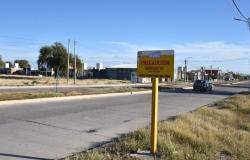On May 29 the national government suspended the supply of gas to industries, CNG stations and thermoelectric plants, as a result of supply problems due to failures in the distribution network and delays in the purchase of imported gas.
According to Indian The Ministry of Energy, led by Eduardo Rodríguez Chirillo, the suspension was due to problems in the transportation network, delays in the import of a shipment of liquefied natural gas (LNG) from Brazil and the advance of low temperatures. The supply began to normalize in the following hours.
In this context, a controversy began regarding the contribution of pipeline President Néstor Kirchner (GPNK) to the system and the delays in the works that would allow expanding the transport capacity of the gas produced in the field of Dead cow. In this note, a review of the current state of the gas pipeline.
What is the current situation of the Presidente Néstor Kirchner gas pipeline?
The Presidente Néstor Kirchner gas pipeline (GPNK) was inaugurated July 9, 2023, although its construction had originally been planned 4 years earlier.
On July 30, 2019, the government of Mauricio Macri (Cambiemos) called a public tender to start the works.
Although the opening of offers was scheduled for September 12, 2019, the deadline was extended on 3 occasions: 2 during Macri’s administration (see here and here) and a during the presidency of Alberto Fernández (Frente de Todos).
Finally, on December 29, 2020 (15 months after the initial deadline), the then Secretary of Energy, Darío Martínez, repealed the call for bids July 2019.
Almost 2 years later, on August 10, 2022, after a controversy between the then Vice President of the Nation, Cristina Fernández de Kirchner, and the then Minister of Production, Matías Kulfas (which led to the resignation of the latter), the national Government signed the contracts of the first stage of the gas pipeline.
Currently, the gas pipeline transports 11 million cubic meters of gas per day, joining the Neuquén town ofTrayén (near Vaca Muerta) with Salliqueló (province of Buenos Aires). However, its capacity could be almost 4 times greater, if the necessary works are in place.
What works are necessary to expand the capacity of the gas pipeline?
In order to expand the capacity of the gas pipeline, it is necessary to install compressor plants, which allow the gas pressure to be increased and, therefore, a greater volume to be transported in less time.
In total, the complete GPNK project includes the construction of 5 compressor plants, which would allow the current transport volume of the gas pipeline to almost quadruple, taking it to 39 million cubic meters per day.
In the first stage, along with the construction of the gas pipeline between Trayén and Salliqueló, the installation of 2 compressor plants was planned, one at each end of the pipeline. These works, according to it was officially stated, They will increase transportation capacity from 11 to 21 million cubic meters.
In what state are the gas pipeline compressor plants?
The works were tendered in November 2022. The Fernández government awarded the construction of theTrayén plant to the company Sacde SA worth $19,925 million; and that of Salliqueló to the Temporary Business Union (UTE) made up of the firms Contreras Hermanos and Esuco SAfor a total of $16,706 million.
In June 2023, the then Chief of Staff Agustín Rossi (Frente de Todos) informed the Chamber of Deputies of the Nation that the works in Trayén would be completed in October of that year and those in Salliqueló, in November. However, during another report provided to the Senate in December 2023, he stated that work would be completed by the end of that month.
However, the works were not completed: the former Secretary of Energy of the Nation, Flavia Royón, assured in his X account that In December, theTrayén plant was 82% complete, and that although its completion had been projected for October 2023, there were “technical and climatic delays.” And he added: “It was necessary to sign an addendum that the current management should have done to continue the work and reach May 2024.”
Checked He asked spokespersons for the former official and the company Energía Argentina (Enarsa) during the previous administration for documents that support these statements, but until the closing of this edition he had not received a response.
For his part, the current Secretary of Energy, Eduardo Rodríguez Chirillo, assured in statements to the Bread and Circus program which is broadcast by Radio Rivadavia that in December 2023 the works “were 6 months late” and that the previous Government maintained debts with the construction companies. “We received Salliqueló with 19% progress of work and 3 months late; andTrayén at 39% with 5 delays. “They left contractors unfunded and debts that this Government should have assumed,” stated in X.
This media outlet consulted the organization’s Press area to obtain supporting documentation, but did not receive responses until the publication of this note. In this situation, Checked presented a request for access to public information.
The latest official information, extracted from report by former Chief of Staff Nicolás Posse to the Senateindicates that the completion date of the work at theTrayén and Salliqueló plants is next June 29.
Meanwhile, to complete the transportation capacity of the gas pipeline it is necessary to complete the second stage of construction, which includes the connection between Salliqueló (where the gas arrives from Vaca Muerta) with San Jerónimo (Santa Fe). This work, together with new compressor plantswould allow transporting 39 million cubic meters per day and supplying Neuquén gas to the Argentine coast.
However, in his report to the Senate Posse noted that “the completion of these works will be the responsibility of the private sector. The work schedule has not been defined, nor the expected bidding date.”
Gas consumption, in numbers
Santiago Urbiztondo, Chief Economist of the FIEL Foundation and specialist in energy issues, pointed out to Checked that the completion of the Treatyén and Salliqueló works would increase gas transportation capacity by 10%, an insufficient volume to meet winter demand.
“Transportation infrastructure is insufficient. Even with the gas pipeline, which has already added 10% to the transportation capacity and could add 10% more, it is not enough,” said the specialist.
For his part, José Sureda, Secretary of Hydrocarbon Resources of the Nation between December 2015 and April 2017, told this medium that “last year the Bahía Blanca regasification ship, which injected about 15 million meters into the system, was dispensed with. cubic daily. The planned expansion works are not enough to compensate for this.”
As explained in this note, gas production in our country grew almost continuously until reaching its historical peak in 2004 (52 billion cubic meters), but then fell until 2015, when it recovered, although without surpassing the record. In 2023, total production reached 48.1 billion cubic meters.
The increase in production recorded in the last decade had its correlation in a 57% drop in imports, which also changed their profile, with a greater incidence of liquefied natural gas (LNG) that arrives to the country through ships and is regasified in the ports of Escobar and Bahía Blanca, and a decline in imports from Bolivia.
In accordance with official datain 2023 power plants consumed 13.1 billion cubic meters (32.1% of the total), while 12.8 billion cubic meters of gas were allocated to industry (31.5% of the total ) and to homes 9.8 billion cubic meters (24.1% of the total).





